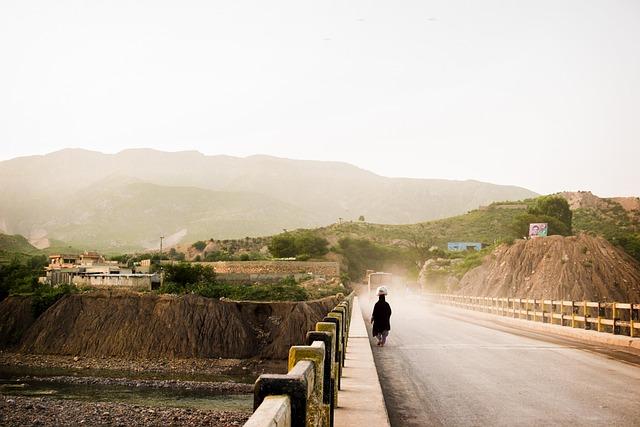In a world marked by shifting alliances and unyielding conflict, Pakistan stands at the crossroads of a tumultuous geopolitical landscape. “Navigating the Shadows” delves into the complex and often troubling narrative of Pakistan’s battle with terrorism—an enduring struggle that weaves through the nation’s social fabric and historical context. As militant ideologies clash with visions of peace and stability, the country grapples with deep-rooted challenges that are at once local and global in nature. From the bustling streets of Karachi to the rugged terrains of Khyber Pakhtunkhwa, the scars of violence influence lives and shape a national identity still emerging from the shadows. In this exploration, we will untangle the intricacies of a fight that is as much about ideology and governance as it is about the resilience and resolve of the Pakistani people. Join us as we seek to illuminate the path forward from the encroaching darkness of extremism, and reflect on the lessons learned from a history fraught with both setbacks and hope.
The Historical Context of Terrorism in Pakistan
The roots of terrorism in Pakistan are deeply intertwined with its complex socio-political landscape. Emerging from the tumultuous partition in 1947, the newly formed state faced the challenge of unifying a diverse population while grappling with lingering regional and religious tensions. Throughout the decades, the geopolitical climate has further complicated matters, especially following the Soviet-Afghan War in the 1980s, which not only introduced a wave of militancy but also entrenched the ideology of jihad. This era saw the birth of various militant groups, many supported by foreign powers, fostering a culture where violence became a means to achieve political ends.
As the decades progressed, factors such as economic instability, political corruption, and foreign intervention fueled the rise of extremist ideologies. The intra-state conflicts, particularly regarding Kashmir and relations with India, have further fueled dissent among disillusioned youths. Additionally, societal issues such as poverty, illiteracy, and lack of social services have created a fertile ground for recruitment into extremist factions. In recent years, the emergence of groups like the Tehrik-i-Taliban Pakistan (TTP) has not only highlighted the sustained internal threats but has also revealed the multifaceted nature of terrorism, where sectarian violence, ethnic strife, and global jihadism coexist, complicating the path toward stability and peace.

Understanding the Root Causes and Motivations Behind Extremism
The myriad factors that contribute to the rise of extremism in Pakistan reveal a complex social and political landscape. Historical grievances, such as past conflicts and perceived injustices, are often cited as catalysts for radicalization. Additionally, economic instability and lack of opportunities can drive disenfranchised individuals towards extremist ideologies in search of purpose and belonging. Cultural and religious narratives also play a significant role, where individuals might exploit or interpret doctrine to justify violence, feeding into a cycle of alienation and rebellion. The following elements are crucial to understanding these motivations:
- Poverty and Unemployment: Economic hardships can foster a sense of desperation.
- Education and Indoctrination: Access to extremist propaganda via schools or online platforms can be influential.
- Social Identity: Individuals may gravitate towards extremist groups seeking community and social acceptance.
Furthermore, the political climate in Pakistan has also influenced the root causes of extremism. State responses to terrorism can sometimes further disenfranchise certain communities, fueling resentment and backlash. Issues such as corruption within government institutions can weaken trust in the state, while localized conflicts or sectarian strife can serve as a breeding ground for extremist ideologies. To thoroughly comprehend the implications, the following table summarizes the interplay between these factors:
| Factor | Impact on Extremism |
|---|---|
| Poverty | Increases vulnerability to radical ideologies. |
| Lack of Education | Limits critical thinking and promotes indoctrination. |
| Political Disenfranchisement | Generates resentment towards the state and its institutions. |
| Religious Manipulation | Exploitation of faith to justify violence. |

Strategies for Strengthening National Security and Community Resilience
To enhance national security and foster community resilience, a multi-faceted approach is essential, focusing on both preventative measures and responsive strategies. Strengthening intelligence networks is crucial for timely information sharing and analysis, which can lead to early intervention against potential threats. Additionally, community engagement initiatives empower local citizens to become vigilant partners in security efforts. By fostering strong relationships between law enforcement and communities, trust is built, making it easier for residents to report suspicious activities. Educational programs aimed at promoting awareness of the various forms of extremism can also play a pivotal role.
Furthermore, establishing structured crisis response mechanisms is vital for quick and effective action during emergencies. This includes creating inter-agency collaboration frameworks that allow for seamless coordination between military, police, and civil institutions. Training sessions and simulations can prepare these entities to respond efficiently, reducing panic and confusion in high-stress situations. Implementing psychological support systems for affected communities post-incident can help rebuild trust and restore normalcy. Below is a simple table highlighting key strategies and their intended outcomes:
| Strategy | Intended Outcome |
|---|---|
| Strengthening Intelligence Networks | Enhanced threat detection and prevention |
| Community Engagement Initiatives | Increased public awareness and vigilance |
| Structured Crisis Response Mechanisms | Swift and effective emergency response |
| Psychological Support Systems | Community healing and restoration of trust |

International Collaboration: A Pathway to Sustainable Solutions
In the face of persistent challenges, international collaboration has emerged as a beacon of hope, illuminating the path toward sustainable solutions in combating terrorism. Countries across the globe are increasingly recognizing that terrorism is not confined by borders; therefore, joint efforts are imperative for effective strategies. Collaborative initiatives can foster knowledge-sharing and resource pooling, enabling nations to tackle radicalization, improve intelligence sharing, and enhance security protocols. By aligning their objectives, countries can harness their strengths to build comprehensive counter-terrorism frameworks.
Furthermore, sustainable solutions require a multifaceted approach that goes beyond military action. It is essential to address the underlying socio-economic factors that fuel extremism. International partnerships can promote development programs that emphasize education, economic opportunity, and community engagement. As part of this effort, the following elements are critical:
- Joint Training Programs: Developing skills for law enforcement agencies across borders.
- Resource Mobilization: Pooling financial and technical resources to support vulnerable regions.
- Policy Harmonization: Aligning legal frameworks to ensure coordinated responses to threats.
- Cultural Exchange Initiatives: Promoting understanding and tolerance among diverse communities.
Concluding Remarks
As we traverse the intricate landscape of Pakistan’s ongoing battle with terrorism, it becomes evident that the journey is fraught with complexities and contradictions. The shadows of extremism loom large, yet they are met with the unwavering resilience of a nation determined to forge a path toward peace and stability. From the deep-seated struggles that punctuate the historical narrative to the multifaceted responses that offer glimmers of hope, Pakistan’s fight against terrorism is not merely a battleground; it is also a testament to the strength of its people and their unyielding spirit.
In this era of uncertainty, where ideologies clash and lives are irrevocably altered, understanding the nuances of Pakistan’s challenges is paramount. It invites us to look beyond the headlines and statistics, to recognize the personal stories entwined within this ongoing saga. As the nation grapples with the duality of shadow and light, it stands at a crossroads, where each decision holds the potential to reshape its future.
The road ahead remains steep and perilous, yet the indomitable will of a nation striving for harmony serves as a powerful counterpoint to the darkness. As we conclude our exploration of this intricate subject, it is imperative to remember that the struggle against terrorism is not solely a political battle; it is a fight for humanity, dignity, and the dreams of generations yet to come. In the shifting sands of time, the lessons learned today may illuminate the path towards a brighter tomorrow—one where the shadows may fade, and hope may rise anew.



